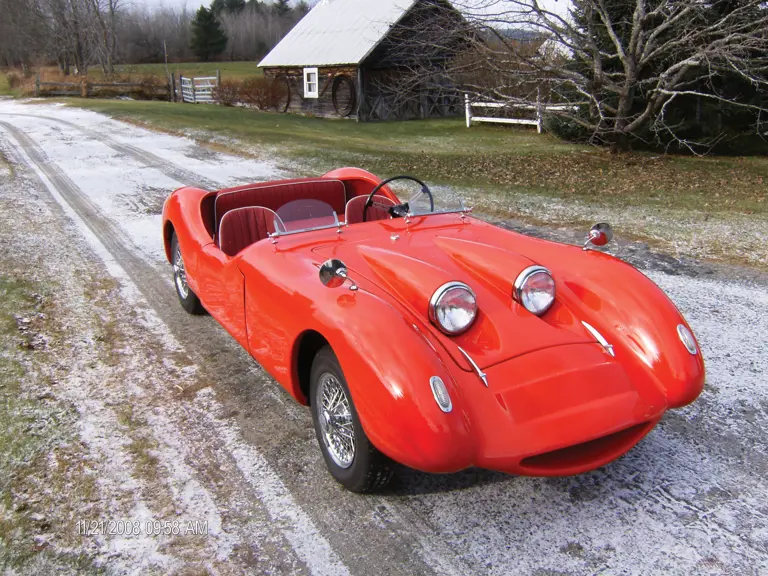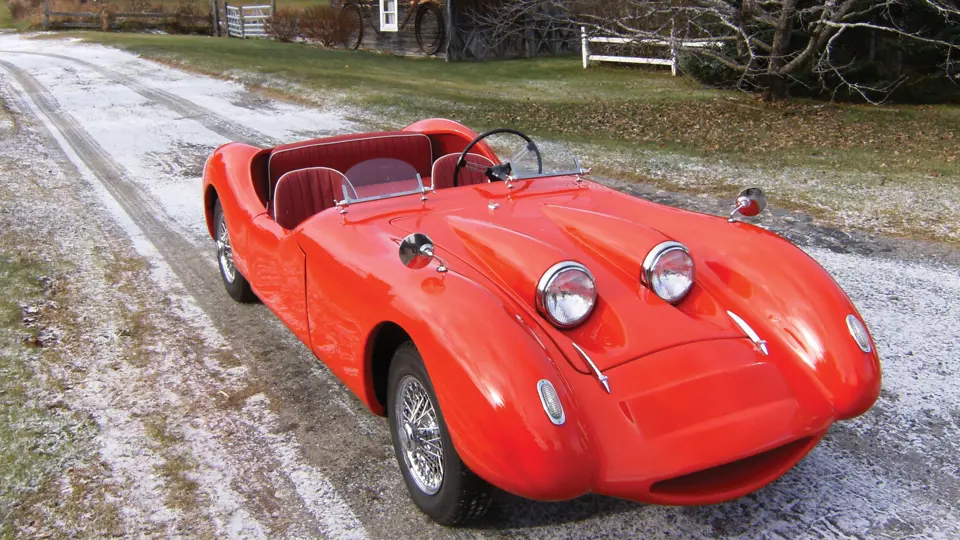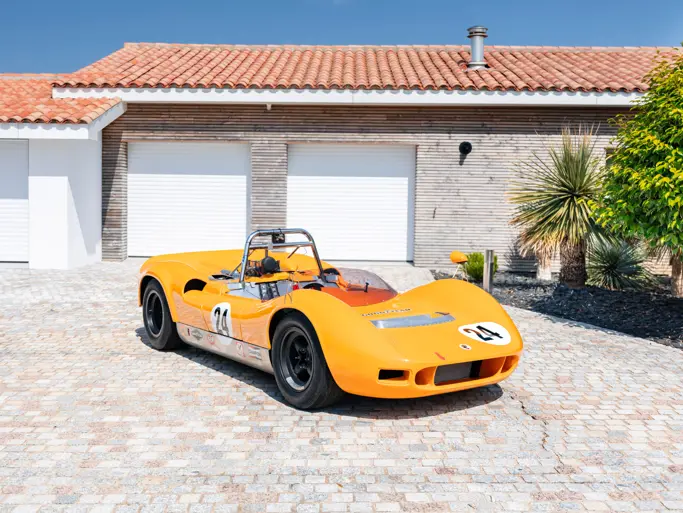 | Fort Lauderdale, Florida
| Fort Lauderdale, Florida
The Westland Empire Aristocrat is reported as a unique one-off prototype British sports car that has had a complete ground-up restoration after being found as a barn find and after pain-staking research and revival through its restoration has won the Chairman's Award at several British Car Shows.
The owners saw this car off-and-on from 1977 to 1981 in various open sheds or fully exposed to the weather. In 1981 it was put into covered storage, but not attended to again until 2003. The car had a mainly full complement of parts inventory, but the condition had deteriorated to the point that a complete restoration would have to be executed, but first the identity of the car would have to be determined.
The frame was found to have been handbuilt. There were no numbers on it and it was longer than any standard frame for similar cars. At 97.5-inches, it turned out to be longer than the Mk I Sprite at 80-inches and the Healey 100-6 and 3000 measured 92-inches. On the fire wall there was a brass plate indicating the car was made by Westland Motor Co. Hereford. England. Model Number W-2. The car had a 1964 Vermont license plate and sticker from “Carpenter and Mayforth,” an auto dealer in Burlington. Vermont.
While the car seemed to have been made from “off-the-shelf” parts; some were actually made specifically for this vehicle - some crudely. The carb manifolds, clutch operating lever, transmission covers and the windscreen are good examples. The fiberglass body, while made following beautiful and quintessential ‘50s lines and well-finished on all outside surfaces, was never finished on the inside and all flanges and edges were just left “cut raw”. The body obviously never fit the frame or parts very well leaving rather large gaps in between doors and front and rear panels. Throughout the restoration these items of concern were left in original condition, but attempts were made to improve the overall fit of doors, boot and bonnet.
Restoration began in 2003. Had it not been for the fiberglass body, there would have been little to restore. When the body was removed, the frame sagged and eventually fell in half. Dale Fadden of Woodsville, New Hampshire replicated the frame. The front end of the frame was salvaged and used in the restoration, thus the shocks (rebuilt) and steering arms are original as are the regulator and fuse panel which sat on cross members.
An MG Midget fuel tank fit the frame members to replace the unidentifiable rusted–out original. The instruments were restored by Niessenger in New York who felt that the identification numbers suggested they came from a Morris Truck. The body was repaired and painted by Darling Auto in Ryegate Vermont. Chrome wire wheels replaced the rusted solid rims and new tires replaced the “Made in England” Pirellis. All remaining restoration was accomplished by the dedicated and enthusiastic owners with the occasional help of others who had special knowledge or talent in regards to this car.
After the strengthened frame was finished with powdercoating, a 948-cc engine was built and the original modified manifolds and carbs were used. The manifolds had had to be modified so as to allow the steering column to pass cleanly. All engine components were taken from the original parts or from Morris 1000s. The original “smoothy” transmission was installed with a new driveshaft. The dash board was remade to original specs. The 100-6 horn button was installed in a modified Morris indicator light switch assembly. As many of the original nut, bolts, washers and other small parts were used; all restored to working usefulness.
As the cars history began to be unraveled, comment was made about the unreliable original clutch mechanism, so this was retrofitted. After many hours of work trying to make the original short lever arm operate the thrust bearing; a new and much longer arm was fabricated and works well. The original transmission tunnel covers did not include the highest part covering from the shift lever to the transmission, so a new final cover was fabricated and an Mk I Sprite boot was utilized.
The carpets were returned to the original red. There were signs of carpet in the boot on the rear seat sides and on the flooring. It was not clear if the carpeting included the fire wall and sides of the foot spaces, but it is now installed in these areas. The bucket seats proved to be a challenge. Austin Seven seats were suggested by many, but they proved to be too narrow by two-inches and Mk I Sprite seats were too wide by two-inches. The result was to cut the two-inches out of the center of Mk I seat frames, backs and covers to result in the custom fit you now see.
Racing screens were installed as there has been no definition of the source of the original windscreen posts. The search of the 500-plus British cars at two British Invasions at Stowe Vermont yielded no information. Fender-mounted mirrors were installed as the only rearview possible had been through a small mirror on the windscreen. The restoration was fully refreshed in 2010.
With the restoration completed and the car running well, the owners took it to the Antique and Classic Car Show in Stowe Vermont where it won the Chairman's Award. This was followed up by the 2006 British Invasion, again in Stowe Vermont where it again won the Chairman's Award. The car was exhibited again at the 2007 British Invasion and the owners discovered that another Westland was being shown in the Concours d'Elegance. They introduced themselves to the owner and discovered that he was the curator of the Healey Museum; Mr. Bill Emerson. When he looked at the car being offered, he immediately identified it as a Westland Healey prototype built for the American market. He later sent us a picture from the Healey museum papers of the car being “presented” outside the Hereford Cathedral with a lady identified as the secretary for Mr. Westland. Bill Emerson also indicated that the Healey papers included engineering drawings of the car referring to it as the “long-nosed” sports car and citing the tubular frame construction.
This prototype car was obviously made for the American market with its left-hand drive, but it was never produced. How it came to America remains unknown. Where it had been during the years 1958 or 59 until 1964 also remain unknown. The car had a 1964 Vermont registration plate; investigation showed that Vermont did not keep records, but the office of registration assured the inquisitive owners that that plate number came from a sequence assigned to Ford trucks! Fortunately, a private individual, Chuck Hayes of Montpelier Vermont had such records and through those more history unfolded.
The car was seen in 1958 or 1959 by Larry Pearry at the Tucker Motor Company in Marblehead Massachusetts. He recalled that the car was referred to locally as “the lobsta.” The car was next seen on the lot at the Carpenter and Mayforth dealership in Burlington Vermont in 1964. While neither Carpenter nor Mayforth recall the car, a picture of the Carpenter and Mayforth lot was provided by Jack Dubrel of Automaster in Shelburne Vermont and from that, Mr. Wentworth Comes of Hancock Vermont identified the lot as the one from which he purchased the car in 1964 and did so by indicating that he did not buy the TR which had been next to it and which is shown in the picture.
Upon seeing the restored car, Mr. Comes immediately declared that it was “my old Aristocrat Thrust” and thus validating the name which the owners had heard in the past from Dan Ludwig. He held the car for one year and registered it as a 1958. He sold the car to an engineer at Cold Regions Research and Engineering Laboratory in Hanover New Hampshire. It was then purchased by Robert Bonnett of East Thetford Vermont, who kept the car between 1966 and 1969. During this time the car lost its engine, seats, most of the upholstery and wiring. He then sold the car to Dan Ludwig of Fairlee Vermont in 1980. Here it remained outdoors or in an open shed until purchased by the current owners who gallantly saved this uncommon machine.
David Mathews, a long-time member of the Association of Healey Owners (AOHO) in England took an interest in determining the origin of this car. Through his efforts a great deal of information came forward. Mr. Mathews ran a picture of the car in the Hereford newspaper and uncovered the true identity of the lady in the included presentation photo. She is Valerie Heins, who became the wife of the professional photographer of the Westland Motor Company. As a result of the newspaper article, David received notifications from persons knowledgeable of the car. This correspondence is reported to provide concrete evidence that the car was built on the Westland factory floor during 1957-1958. While a few parts of the mystery remain, this is a car that has its own and exclusive story with documentation that most car aficionados long for when selecting their next investment.





